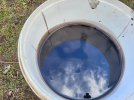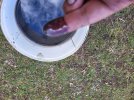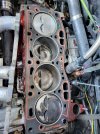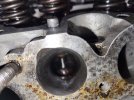petex19
True Classic
Didn't know what to put as a title as so many issues took place. I wasn't going to post but I figured that if I can't figure out the why then I can't prevent it from happening again.
I replaced my distributor and car fired right up. Setting my timing advance, I noticed the exhaust smoke was on the white side so I shut it off. I pulled plug #1 and it was a good black/brown color but I couldn't smell much fuel on it. I figured the exhaust smoke would clear so I continued setting the timing. After another 30sec I didn't like the color of the exhaust so I stopped. I pulled all 4 plugs and cyl#4 was white whereas the others were black. I pulled the oil dipstick and it was black/grey. Not the color oil should be but not chocolate milk indicating a blown head gasket.
I had to know what damage was done so I started removing the head. The cam box gasket was in pieces. The head gasket looks like the day it was installed. Piston #4 is washed on the top whereas the other 3 look as they should. No visible damage to the piston tops, head or cam box.
I will have the head and cam box looked over by a machine shop as well as the valves. Visibly all the valves except the intake valve cyl#4 look brand new looking through the intake and exhaust ports. Intake cyl#4 just looks like the finish came off the inside part of the valve which is probably from the heat.
The car wasn't driven and total running time was probably under 4min total setting the timing.
There was no detonation or anything. I expected to see a blown head gasket but that didn't happen.
What could have caused this. Over advancing it setting the timing?
Water pump failure?
Carbs running too lean?
I had 3psi of fuel going to my carbs.
I took pictures of the block with the head gasket and of the oil. Hard to tell in the pail but on my finger it's easier to see it's not black.
I replaced my distributor and car fired right up. Setting my timing advance, I noticed the exhaust smoke was on the white side so I shut it off. I pulled plug #1 and it was a good black/brown color but I couldn't smell much fuel on it. I figured the exhaust smoke would clear so I continued setting the timing. After another 30sec I didn't like the color of the exhaust so I stopped. I pulled all 4 plugs and cyl#4 was white whereas the others were black. I pulled the oil dipstick and it was black/grey. Not the color oil should be but not chocolate milk indicating a blown head gasket.
I had to know what damage was done so I started removing the head. The cam box gasket was in pieces. The head gasket looks like the day it was installed. Piston #4 is washed on the top whereas the other 3 look as they should. No visible damage to the piston tops, head or cam box.
I will have the head and cam box looked over by a machine shop as well as the valves. Visibly all the valves except the intake valve cyl#4 look brand new looking through the intake and exhaust ports. Intake cyl#4 just looks like the finish came off the inside part of the valve which is probably from the heat.
The car wasn't driven and total running time was probably under 4min total setting the timing.
There was no detonation or anything. I expected to see a blown head gasket but that didn't happen.
What could have caused this. Over advancing it setting the timing?
Water pump failure?
Carbs running too lean?
I had 3psi of fuel going to my carbs.
I took pictures of the block with the head gasket and of the oil. Hard to tell in the pail but on my finger it's easier to see it's not black.







